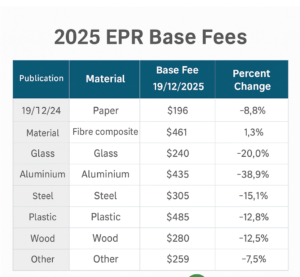2025 EPR Packaging Fees Published: What Producers Need to Know
Base Fees for Producers Finalised by PackUK
On 27 June 2025, PackUK (formerly the Scheme Administrator) released the final EPR base fees for packaging producers, replacing the provisional figures from December 2024. These fees form the core financial obligation for producers under the regime and will be invoiced in October.
The announcement brought relief for many producers, particularly those dealing with glass and aluminium, which saw substantial reductions in cost. Others, such as fibre composites, experienced a small increase.
How Fees Have Changed – Material by Material
The updated base fees (shown in millions) reveal a clear downward trend in most categories. The graph below compares June 2025 figures with those published in December 2024:
2025 Base Fee Cost per Material (in £m)
Key takeaways from the data:
- Glass fees dropped by 20%, the largest decrease after aluminium.
- Plastic continues to represent the highest overall cost to producers, rising to nearly £600m.
- Fibre composite was the only category to increase (+1.3%), though its overall volume remains modest.
- Aluminium fees fell sharply by nearly 39%, reflecting reduced weightings or changes in exemption status.

Percentage Contribution to Total Fee by Material
The second chart illustrates how each material now contributes to the total base fee. While plastic still dominates, the relative share of other materials has shifted:
Percentage of Total Base Fee by Material
Notable changes include:
- Glass dropped from 29.2% to 27.1% of the total.
- Plastic now accounts for 38.4% of the total base fee – up slightly from 37.9%.
- Paper saw a small increase in its percentage contribution (22.7% to 24.1%).
These shifts highlight evolving priorities in the EPR framework and how fee burdens are redistributed as data is refined.
What Does It Mean for Producers?
Using 2023 Valpak Packflow data, total contributions are projected to reach £1.46 billion in 2025. This includes household packaging tonnage (excluding drinks containers under DRS) and binned packaging.
Invoices will be issued in October, based on centralised calculations. Payments may be split into four instalments. For glass, which remains only partially included in DRS (and only in Wales), a fixed figure of 2.05m tonnes has been used for consistency in calculation.
Regulatory Flexibility and Clarifications
The June announcement was accompanied by a Regulatory Position Statement confirming that enforcement will not apply to the recyclability modulation system for H1 2025. However, producers must still differentiate between rigid and flexible plastic formats.
Defra has also acknowledged flaws in how “household packaging” is defined. This includes ‘dual-use’ packaging used in the hospitality sector but currently charged under the household category, such as shampoo bottles in hotels. A review is underway to address this disparity.
Reassurance on Local Authority Funding
Concerns had been raised that base fees might be diverted to cover broader local government shortfalls. In response, Defra clarified that funds will be ringfenced for household packaging waste only. PackUK is instructed to ensure full compliance under the current pEPR framework.
The 2025 EPR base fees provide greater clarity and fairness across packaging materials, especially with significant reductions for glass and aluminium. While plastic remains the highest cost material, its share has remained stable. These changes reflect a more refined and data-driven approach to Extended Producer Responsibility, though further clarification is still required in areas such as dual-use packaging and export dependencies.